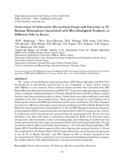Occurrence of Arbuscular Mycorrhizal Fungi and Fusarium in TC Banana Rhizosphere Inoculated with Microbiological Products in Different Soils in Kenya

View/
Date
2015Author
Mukhongo, R W
Kavoo-Mwangi, M A
Kahangi, M E
Ateka, E M
Were, A B
Okalebo, JR
Mutegi, ME
Mwangi, KE
Tepeni, TT
Njuguini, KS
Onguso, JM
Okoth and, SA
Jefwa, JM
Language
enMetadata
Show full item recordAbstract
The impact of microbiological commercial
products (PHC Biopak, Rhizatech and ECO-T) on
the occurrence of mycorrhizae and
Fusarium
in the rhizosphere of tissue culture banana
(Gros Mitchel cv.) was assessed. Tissue cultured banana plantlets were inoculated with PHCBiopak (Bacillus), Rhizatech (mycorrhiza) and ECO-T (T. harzianum) under greenhouse conditions
using a completely randomized design in a Vertisol, Rhodic Ferralsol and Humic Nitisol sampled
from the major banana growing regions in Kenya.
Potted plants were later established under field
conditions in the three agro ecological zones.
Roots and soils sampled at end of potting and at
flowering were assessed for
AM fungi colonization and
Fusarium
populations. The effect of product
inoculation on AM fungi colonization varied and only significant (p<0.05) in RhodicFerralsol with
Rhizatech increasing intensity of colonization by
31.9% and PHC Biopak increasing the frequency
of colonization by 38.6% compared to the non-inoculated control (12.9%).
F. oxysporum, fsp. cubense,F. proliferatum
and
F. incarnatum
were recovered from the experimental soils. Foc
was the most
abundant in the three soils (prior to inoculation) accounting for 60.6% of all
Fusarium colony
forming units. After inoculation, at the end of potting stage and at flowering,
F. proliferatum
was
mostly isolated from the three zones accounting for 35.2% of the total fungal population.
Foc was
isolated from Humic Nitisol and Vertisol accountin
g for 11.5% of the total fungal population. PHC
Biopak, ECO-T and Rhizatech suppressed
Foc
colony forming units per gr
am of soil by 47, 68 and
55%, respectively in the Humic Nitisol. ECO-T reduced
Fusarium
colony forming units per gram
of soil by 6% in Rhodic Ferralsol and PHC Biopak by 50% in Vertisol compared to the
non-inoculated soils. There is potential in use of
commercial microbiological products to suppress
Foc
and the efficacy of the products depends on soil physico-chemical properties
URI
http://search.proquest.com/openview/1034ecc10a451c276760a389ef88b4de/1?pq-origsite=gscholarhttp://hdl.handle.net/11295/92575
Citation
Mukhongo, R W; Kavoo-Mwangi, M A; Kahangi, M E; Ateka, E M; Were, A B; et al. International Journal of Soil Science10.2 (2015): 45-62.Publisher
University of Nairobi
